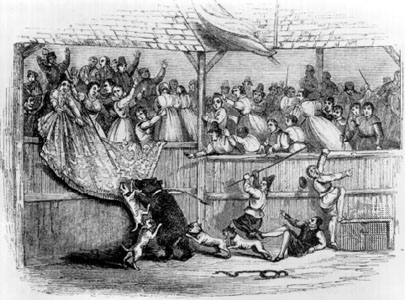Bear-Baiting
Dogs
Bear-Baiting
 Bear-baiting in the 18th century, engraving, 1796
Bear-baiting in the 18th century, engraving, 1796
Bear-baiting is a
blood
sport that was a popular entertainment from at least the
11th
century in which a
bear is secured to a post and then attacked by a number of
dogs.
In the most well known form, there were purpose-built arenas for the
entertainment, called in
England
bear-gardens, consisting of a circular high fenced area, the pit, and raised
seating for spectators. A post would be set in the ground towards the edge of
the pit and the bear chained to it, either by the leg or neck. The dogs would
then be set on it, being replaced as they tired or were wounded or killed. For a
long time the main bear-garden in
London was the
Paris Garden at
Southwark.
In England, from the 16th century, many
herds of bears
were maintained for baiting.
Henry VIII was a fan and had a pit constructed at
Whitehall.
Elizabeth I was also fond of the entertainment; it featured regularly in her
tours. In 1575 a baiting display for her had thirteen bears, and when an attempt
was made to ban baiting on Sundays she over-ruled
Parliament. A variation was "the whipping of a blinded bear" and certain
other animals were also baited, especially
bulls
but also on one curious occasion a
pony with an
ape tied to its back
was baited and a spectator described that "...with the screaming of the ape,
beholding the curs hanging from the ears and neck of the pony, is very
laughable".
Attempts to end the entertainment were first made in England by the
Puritans,
with little effect. In 1849, Catharine Macaulay wrote,"The Puritan hated
bearbaiting, not because it gave pain to the bear, but because it gave pleasure
to the spectators."
By the late
17th
century "the conscience of cultivated people seems to have been touched",
but it was not until
1835 that baiting were prohibited by Parliament, a ruling that was soon
extended across the
Empire. Baiting is banned worldwide but can still be found in parts of the
Middle
East and
Pakistan.
The term may also be used for the hunting practice of luring a bear with bait
to an arranged killing spot. The hunter places an amount of food, such as raw
meat and/or sweets, every day at a given spot until the hunter notices the food
is being taken each day, accompanied by bear tracks. He then chooses a day to
await the bear, killing it when it arrives to feed. Because the practice is time
consuming and disrupts a person's daily schedule, the term "bear baiting" is
sometimes also used in Alaska to mean "screwing off," for example if a person is
late for work or misses an appointment.
A bear-bait filled a significant symbolic role as the turning point in
Ken
Follett's book,
The Pillars of the Earth.
See also
External link
Home | Up | Badger-Baiting | Rat-Baiting | Bear-Baiting | Bull-Baiting | Dog Fighting | Hog-Baiting | Human-Baiting | Lion-Baiting | Polar Bear-Baiting
Dogs, made by MultiMedia | Free content and software
This guide is licensed under the GNU
Free Documentation License. It uses material from the Wikipedia.
|




